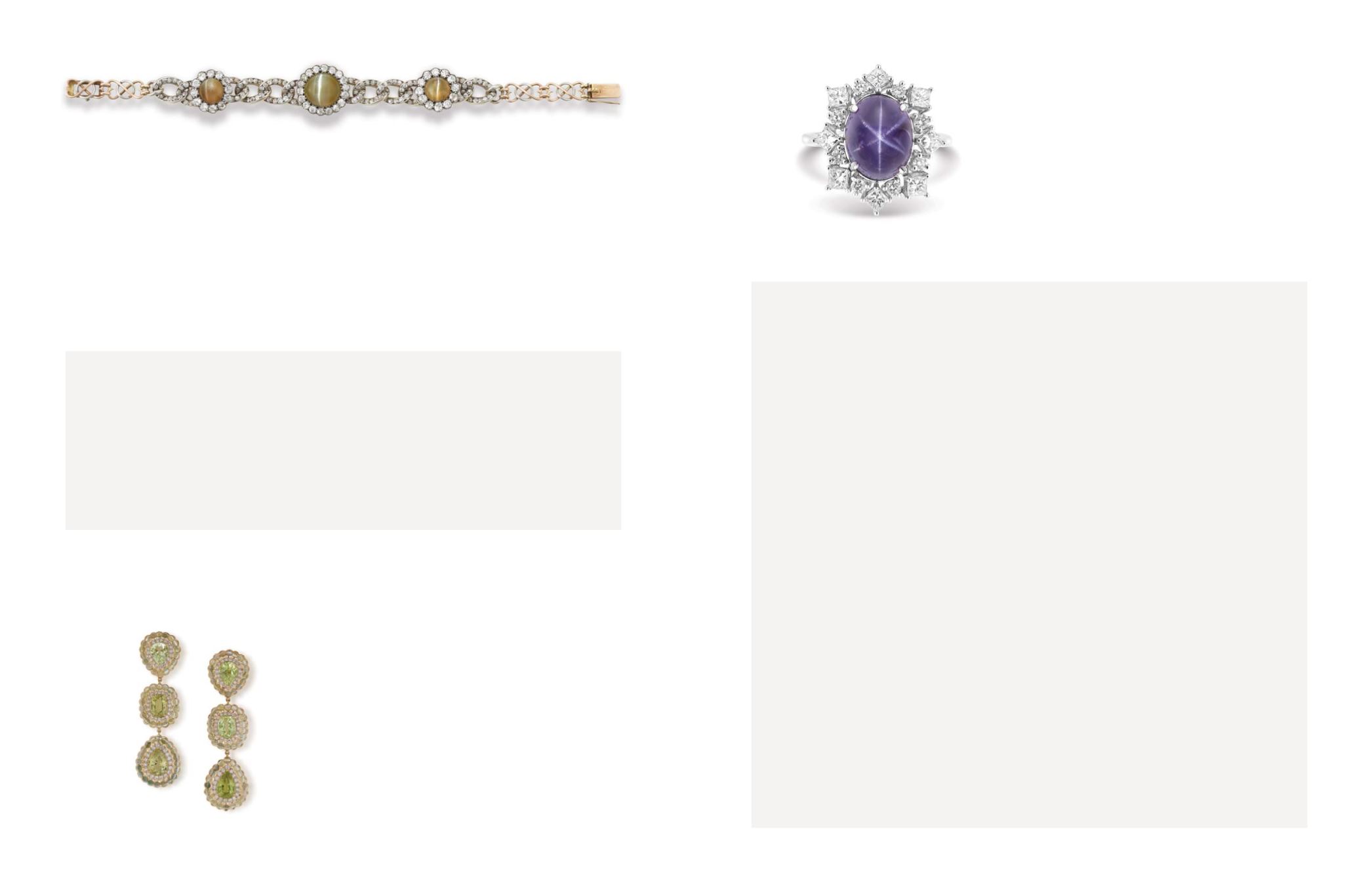

88
89
110
PAIR OF GEMSET EARRINGS
Each designed as a flexible line of three plaques,
centring a chrysoberyl to a surround of cat’s eye
chrysoberyl, mounted in gold. Stamped ‘18K’.
Chrysoberyl: 19.91 carats
Cat’s eye chrysoberyl: 9.63 carats
Diamond: 2.04 carats
Gross weight: 26.15 grams
$ 5,715 ‒ 7,145
Rs 4,00,000 ‒ 5,00,000
111
STAR PURPLE SAPPHIRE AND
DIAMOND RING
Centring on an oval‒shaped cabochon purple star
sapphire, with a surround of alternating square and
round diamonds, mounted in gold. Stamped ‘18K’.
Star purple sapphire: 7.54 carats
Diamond: 1.12 carats
Gross weight: 7.88 grams
$ 8,575 ‒ 10,000
Rs 6,00,000 ‒ 7,00,000
109
CAT’S EYE CHRYSOBERYL AND
DIAMOND BRACELET
Designed as a flexible bracelet with three gently
graduating cabochons of cat’s eye chrysoberyl, with
full‒cut diamond surrounds connected by similarly
designed diamond‒set links, mounted in gold.
Gross weight: 15.98 grams
$ 12,145 ‒ 15,000
Rs 8,50,000 ‒ 10,50,000
O
ne of the oldest and best known coloured precious stones, sapphires are composed of a
colourless material known as corundum. The deep blue colour most commonly associated
with this gemstone is caused by the addition of titanium and iron during its formation. However,
fancy sapphires occur in a varied spectrum of colours, including ‘pink’ sapphires, which can
range from shades of red to purple.
Many sapphires contain inclusions, such as those which cause the stone to have a star‒like
appearance – a phenomenon known as asterism, originating from the ancient Greek word for
‘star.’ This effect is caused by thin mineral needles which are aligned such that they reflect
and “scatter light, causing the coveted visual effect without negatively affecting the gem’s
transparency,” and effectively increasing the value of the stone. “The best star corundum has a
crisp, distinct star against strongly saturated colour,” which is situated at the top of the stone, has
straight rays, and moves smoothly across the surface. (“Sapphire Quality Factors,”
GIA
,
gia.edu,online) The stone must be cut as a cabochon to exhibit asterism, and the number of intersecting
bands (usually 2, 3 or 6) determine the rays of the star. In the present lot, three streaks create a
mesmerising six‒ray star.
These luminous, highly durable stones were considered powerful and mystical talismans,
bringing luck and protection to travellers and seekers. They were referred to by some as “the
stone of destiny.” According to legend, “The celebrated explorer Sir Richard Francis Burton
travelled the Orient with a large star sapphire, known as an
asteria
. He found it brought him
much luck, as the stone’s fame preceded him in his travels. Many believed simply viewing the
talisman meant good fortune.” (Fara Braid, “Sapphire Symbolism,”
International Gem Society
,
gemsociety.org, online)
Some of the largest star sapphires in the world – including the blue
Star of Adam
(1404.49 carats),
the greyish‒blue
Star of India
(563.4 carats), and the violet‒blue
Star of Bombay
(182 carats) –
were mined in Sri Lanka, and the world’s second largest star sapphire,
Black Star of Queensland
(733 carats) was discovered in Australia. Other significant locations of star sapphire deposits are
Myanmar and Thailand.
T
he present lot contains chrysoberyls, one of the few gemstones that exhibit chatoyancy
or the ‘cat’s eye’ effect. This phenomenon occurs due to sets of rutile needles inside the
stone aligned in the same direction. When light interacts with the needles, it produces a streak
of light that reflects from the dome of the stone. This effect is most pronounced when the
stone is cut to produce a cabochon. Translucent‒yellowish in colour, the cat’s eye chrysoberyl
originates in Brazil, India and Sri Lanka, and is one of the nine auspicious gems or
navratna
in Indian astrology.


















